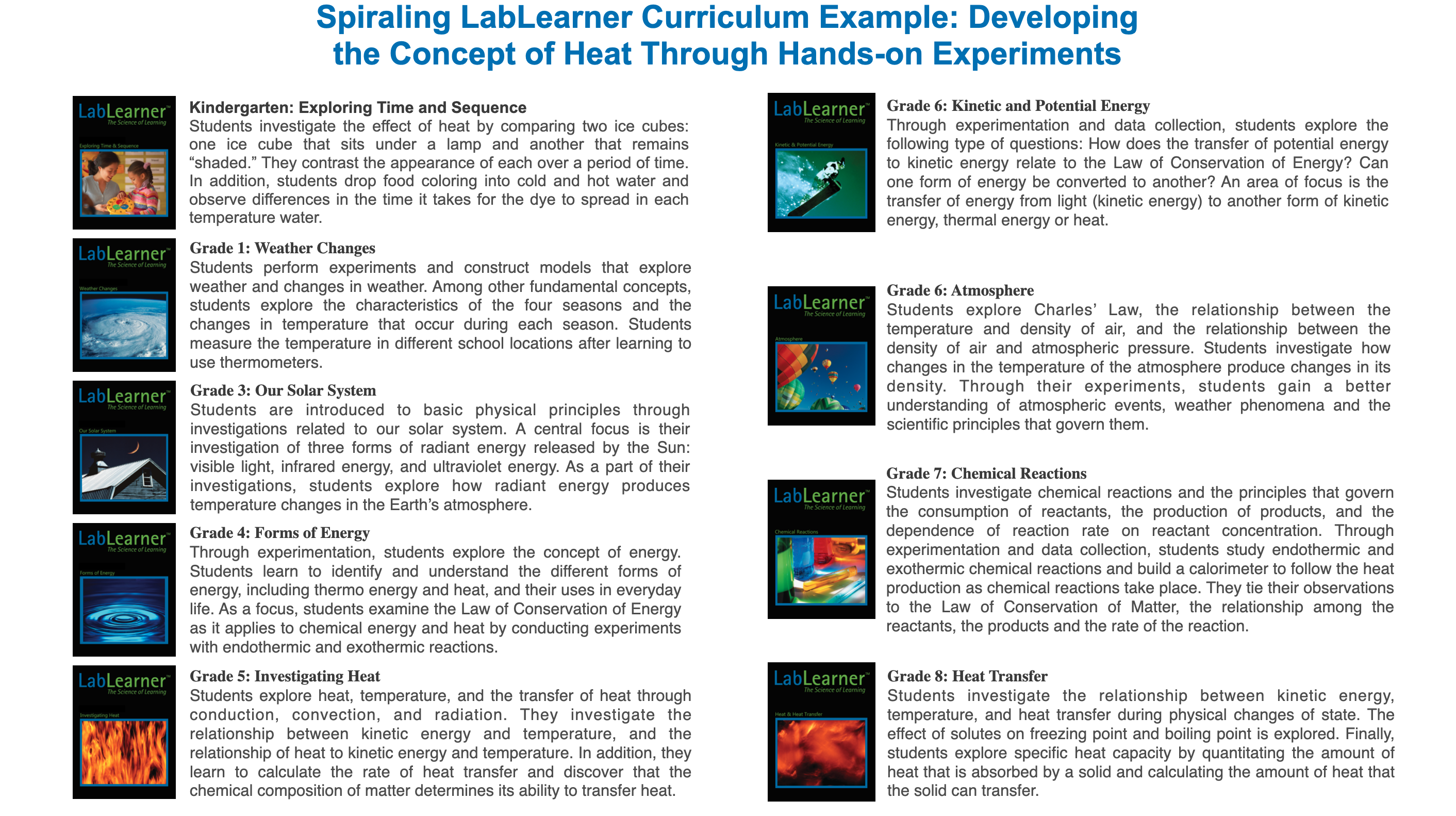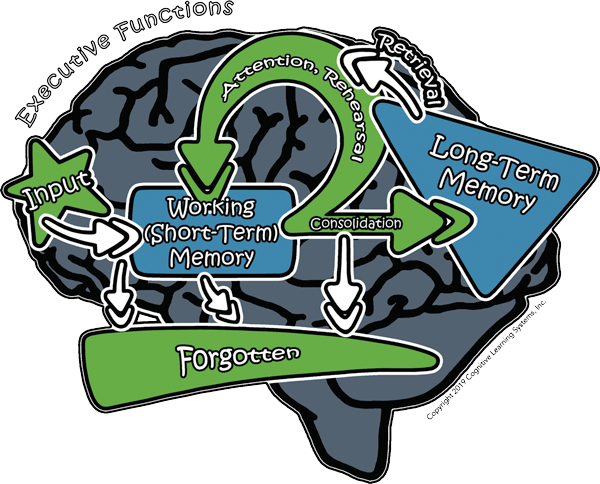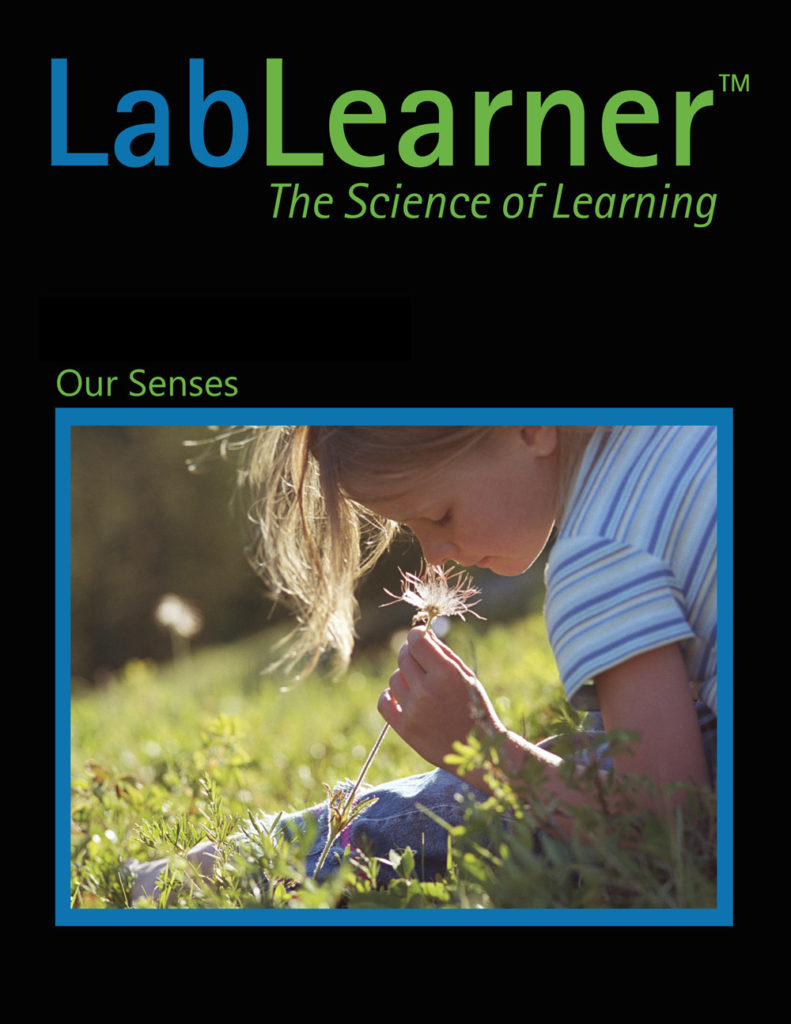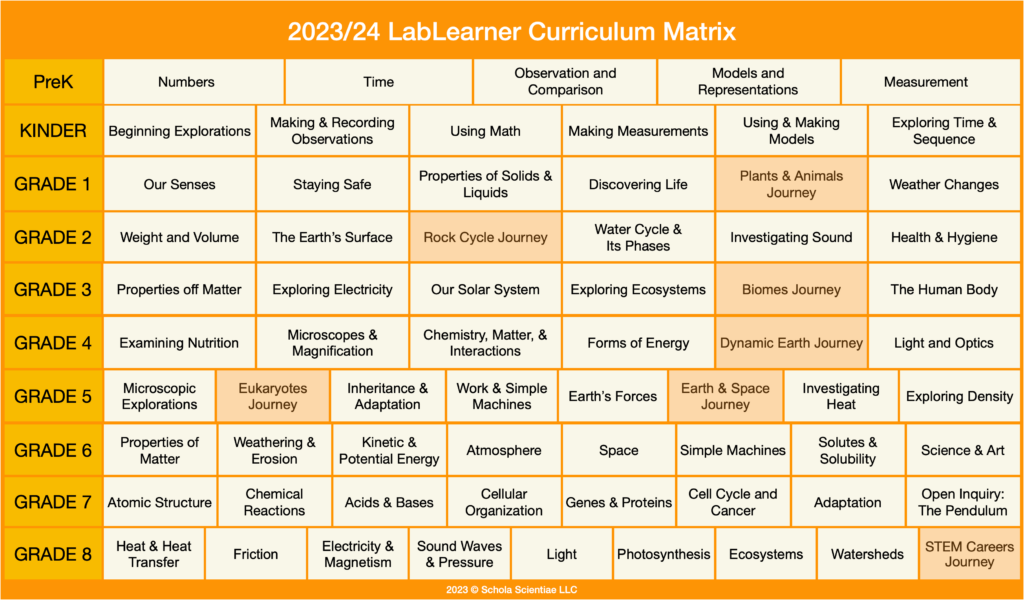The LabLearner Curriculum:
Spiraling, Rigorous, and Research-Based
The LabLearner curriculum has been developed and refined over a period of nearly two decades. The curriculum framework and details are based on neurocognitive data and human learning research. We have always placed special emphasis on classroom logistics and best educational practices through collaboration with practicing teachers. A quick glance at the sample curriculum matrix shown below clearly demonstrates how LabLerner clusters science, mathematics, technology, and engineering skills into units (well call them CELLs) rather than simply a list of disparate factoids and disconnected concepts. The LabLearner curriculum is based on how humans best acquire, understand, and assimilate knowledge. And isn’t that what education is all about?
The creation, development, and evolution of a curriculum can only occur in a classroom. We have spent thousands of hours in classrooms across the country, working directly with teachers and students, creating and developing the LabLearner curriculum. It’s this combination of careful research and the ability to listen to teachers and school administrators that has led to the well-conceived and thoughtful curriculum that you see today.
Spiraling Curriculum:
Building Upon and Reiterating Concepts, Year After Year
Since 2004, rather than thinking in isolated categories like Biology, Chemistry, Earth Science, and Physics, our LabLearner science curriculum began to revolve around specific Core Concepts™ which we believed offered a much more useful way to organize elementary and middle school science instruction. It also results in a spiraling curriculum where scientific concepts build upon each other, year after year. This is precisely the recommendation of the Next Generation Science Standards (NGSS).
Over 60 CELLs (Core Experience Learning Labs) are strategically inserted throughout the PreK-8 educational experience for a truly spiraling curriculum (see an example of the spiraling of heat concepts below). At each grade level, developmental and academic skills are accounted for. These skills range from mathematical, reading, writing, critical thinking, and fine motor skills, among others.
In addition, LabLearner CELLs have been designed so that essential scientific themes spiral throughout the curriculum from PreK through eighth grade, taking into account the neurocognitive processing mechanisms of elementary and middle school students while remaining perfectly correlated with academic standards.

Science Standards:
Next Generation Science Standards Approach
Since that time, LabLearner has used the same conceptual and structural approach in the organization of over 350 curriculum-embedded complete lab experiments to form a continuous, logical sequence of STEM learning experiences. Beyond the cross-cutting concepts, the LabLearner Program is infused with Common Core English Language Arts (ELA) and Math Standards.
- LabLearner Core Concepts
- Systems and System Models
- Energy and Matter
- Stability and Change
- Scale, Proportions, and Quantity
- Patterns, Cause, and Effect
- Structure and Function
Science Standards:
Next Generation Science Standards Approach
Since that time, LabLearner has used the same conceptual and structural approach in the organization of over 350 curriculum-embedded complete lab experiments to form a continuous, logical sequence of STEM learning experiences. Beyond the cross-cutting concepts, the LabLearner Program is infused with the Common Core English Language Arts (ELA) and Math Standards.

- LabLearner Core Concepts
- Systems and System Models
- Energy and Matter
- Stability and Change
- Scale, Proportions, and Quantity
- Patterns, Cause, and Effect
- Structure and Function
All Assessments Included:
Authentic Performance Assessments, Unit Exams, and Weekly Quizzes
Most educators and researchers agree that science should primarily be taught in a hands-on, experiential fashion. Thus, the baseline question for educators and researchers in the field of science education today is: What constitutes a good, successful science experience for students and how do we assess their performance? LabLearner believes that a wide variety of assessment tools should be used and that assessment must be done on a regular, frequent basis.
LabLearner even provides a PreExam and PostExam for every single unit CELL. Teachers and curriculum directors can therefore directly and quantitatively gauge student success on a weekly basis for the entire PreK-8 STEM education experience.
Finally, formal Performance Assessments provide an opportunity for student lab groups to demonstrate their prowess in scientific thinking, problem-solving strategies, and laboratory skills under the authentic conditions of a lab setting – the best assessment paradigm available.

All Assessments Included:
Authentic Performance Assessments, Unit Exams,
and Weekly Quizzes

Most educators and researchers agree that science should primarily be taught in a hands-on, experiential fashion. Thus, the baseline question for educators and researchers alike in the field of science education today is: What constitutes a good or successful science experience for students and how do we assess their performance? LabLearner believes that a wide variety of assessment tools should be used and that assessment must be done on a regular, frequent basis.
LabLearner even provide a PreExam and PostExam for every single unit CELL. Teachers and curriculum directors can therefore directly and quantitatively gauge student success on a weekly basis for the entire PreK-8 STEM education experience.
Finally, formal Performance Assessments provide an opportunity for student lab groups to demonstrate their prowess in scientific thinking, problem-solving strategies, and laboratory skills under the authentic conditions of a lab setting – the best assessment paradigm available.
Neurocognitive Underpinnings:
The Information Processing Model
 Information processing is important in learning and memory. In fact, if new information is not processed it will not lead to permanent new memories and learning will not occur. Therefore, the more extensively new information is processed, the better it will be remembered. The steps involved in the input and processing of new information is summarized in the Information Processing Model. Let’s briefly consider this model in overview.
Information processing is important in learning and memory. In fact, if new information is not processed it will not lead to permanent new memories and learning will not occur. Therefore, the more extensively new information is processed, the better it will be remembered. The steps involved in the input and processing of new information is summarized in the Information Processing Model. Let’s briefly consider this model in overview.
The Input arrow indicates new information entering the brain. Most information that we are presented with never makes it through the sensory register and is lost as indicated by the downward arrow on the left (leading to “Forgotten”). We receive an enormous amount of information, thousands of stimuli per second… (learn more)
Focus on the Senses:
Elementary School Cognitive Enrichment
Children naturally learn through curiosity and exploration. Motivated by novelty, curiosity, and social interactions, children are drawn to sights, sounds, and actions that are interesting and stimulating. Learning activities that engage their senses and prompt responses induce more brain stimulation. Such experiences engage the “whole brain”, which in turn, increases the chances that every child will find their own strengths in learning.
Consequently, at the elementary school level, Neurocognitive Enrichment begins by introducing the five senses – smell, sight, touch, taste, and hearing. For each of the senses, students begin to understand that while our various sense organs collect information from the environment, it is the brain that permits us to understand the meaning of what our senses experience.
Elementary school students conduct simple hands-on experiments that demonstrate the unique types of information each sense collects and transfers to the brain. In addition, important safety information is presented concerning protecting the brain from injury. The importance of bicycle helmets and seatbelts, for example, are explored in terms of preventing head injuries through hands-on lab experiences.

Focus on the Senses:
Elementary School Cognitive Enrichment
Children naturally learn by curiosity and exploration. Motivated by novelty, curiosity, and social interactions, children are drawn to sights, sounds, and actions that are interesting and stimulating. Learning activities that engage their senses and prompt responses induce more brain stimulation. Such experiences engage the “whole brain”, which in turn, increases the chances that every child will find their own strengths in learning.
Consequently, at the elementary school level, Neurocognitive Enrichment begins by introducing the five senses – smell, sight, touch, taste, and hearing. For each of the senses, students begin to understand that while our various sense organs collect information from the environment, it is the brain that permits us to understand the meaning of what our senses experience.
Elementary school students conduct simple hands-on experiments that demonstrate the unique types of information each sense collects and transfers to the brain. In addition, important safety information is presented concerning protecting the brain from injury. The importance of bicycle helmets and seatbelts, for example, are explored in terms of preventing head injuries through hands-on lab experiences.


